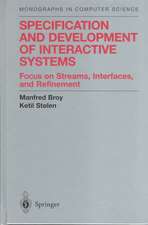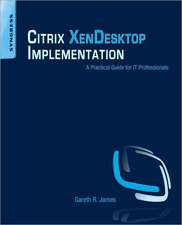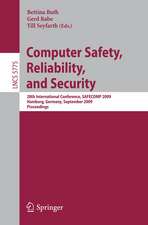Cyber-Risk Management: SpringerBriefs in Computer Science
Autor Atle Refsdal, Bjørnar Solhaug, Ketil Stølenen Limba Engleză Paperback – 12 oct 2015
The content is divided into three parts. First, part I provides a conceptual introduction to the topic of risk management in general and to cybersecurity and cyber-risk management in particular. Next, part II presents the main stages of cyber-risk assessment from context establishment to risk treatment and acceptance, each illustrated by a running example. Finally, part III details four important challenges and how to reasonably deal with them in practice: risk measurement, risk scales, uncertainty, and low-frequency risks with high consequence.
The target audience is mainly practitioners and students who are interested in the fundamentals and basic principles and techniques of security risk assessment, as well as lecturers seeking teaching material. The book provides an overview of the cyber-risk assessment process, the tasks involved, and how to complete them in practice.
Din seria SpringerBriefs in Computer Science
-
 Preț: 475.83 lei
Preț: 475.83 lei - 20%
 Preț: 166.97 lei
Preț: 166.97 lei - 20%
 Preț: 325.63 lei
Preț: 325.63 lei - 20%
 Preț: 349.15 lei
Preț: 349.15 lei - 20%
 Preț: 302.49 lei
Preț: 302.49 lei -
 Preț: 381.81 lei
Preț: 381.81 lei -
 Preț: 446.47 lei
Preț: 446.47 lei - 20%
 Preț: 296.17 lei
Preț: 296.17 lei - 20%
 Preț: 335.66 lei
Preț: 335.66 lei - 20%
 Preț: 463.83 lei
Preț: 463.83 lei - 20%
 Preț: 323.00 lei
Preț: 323.00 lei - 20%
 Preț: 322.35 lei
Preț: 322.35 lei - 20%
 Preț: 321.85 lei
Preț: 321.85 lei - 20%
 Preț: 232.68 lei
Preț: 232.68 lei -
 Preț: 375.45 lei
Preț: 375.45 lei - 20%
 Preț: 323.00 lei
Preț: 323.00 lei - 20%
 Preț: 322.81 lei
Preț: 322.81 lei - 20%
 Preț: 324.17 lei
Preț: 324.17 lei - 20%
 Preț: 323.00 lei
Preț: 323.00 lei - 20%
 Preț: 322.17 lei
Preț: 322.17 lei - 20%
 Preț: 322.50 lei
Preț: 322.50 lei - 20%
 Preț: 323.34 lei
Preț: 323.34 lei - 20%
 Preț: 324.17 lei
Preț: 324.17 lei - 20%
 Preț: 323.46 lei
Preț: 323.46 lei - 20%
 Preț: 322.17 lei
Preț: 322.17 lei - 20%
 Preț: 322.02 lei
Preț: 322.02 lei -
 Preț: 341.50 lei
Preț: 341.50 lei - 20%
 Preț: 324.49 lei
Preț: 324.49 lei -
 Preț: 344.47 lei
Preț: 344.47 lei -
 Preț: 376.80 lei
Preț: 376.80 lei -
 Preț: 377.18 lei
Preț: 377.18 lei - 20%
 Preț: 324.17 lei
Preț: 324.17 lei - 20%
 Preț: 352.26 lei
Preț: 352.26 lei - 20%
 Preț: 321.32 lei
Preț: 321.32 lei - 20%
 Preț: 322.17 lei
Preț: 322.17 lei - 20%
 Preț: 324.17 lei
Preț: 324.17 lei - 20%
 Preț: 322.02 lei
Preț: 322.02 lei -
 Preț: 374.46 lei
Preț: 374.46 lei - 20%
 Preț: 320.21 lei
Preț: 320.21 lei - 20%
 Preț: 323.34 lei
Preț: 323.34 lei - 20%
 Preț: 324.17 lei
Preț: 324.17 lei - 20%
 Preț: 231.84 lei
Preț: 231.84 lei - 20%
 Preț: 294.97 lei
Preț: 294.97 lei - 20%
 Preț: 322.50 lei
Preț: 322.50 lei - 20%
 Preț: 323.46 lei
Preț: 323.46 lei -
 Preț: 374.08 lei
Preț: 374.08 lei -
 Preț: 408.23 lei
Preț: 408.23 lei - 20%
 Preț: 321.52 lei
Preț: 321.52 lei - 20%
 Preț: 323.34 lei
Preț: 323.34 lei - 20%
 Preț: 323.00 lei
Preț: 323.00 lei
Preț: 467.93 lei
Preț vechi: 584.91 lei
-20% Nou
Puncte Express: 702
Preț estimativ în valută:
89.55€ • 97.24$ • 75.22£
89.55€ • 97.24$ • 75.22£
Carte tipărită la comandă
Livrare economică 22 aprilie-06 mai
Preluare comenzi: 021 569.72.76
Specificații
ISBN-13: 9783319235691
ISBN-10: 3319235699
Pagini: 146
Ilustrații: XI, 145 p. 32 illus.
Dimensiuni: 155 x 235 x 10 mm
Greutate: 0.23 kg
Ediția:1st ed. 2015
Editura: Springer International Publishing
Colecția Springer
Seria SpringerBriefs in Computer Science
Locul publicării:Cham, Switzerland
ISBN-10: 3319235699
Pagini: 146
Ilustrații: XI, 145 p. 32 illus.
Dimensiuni: 155 x 235 x 10 mm
Greutate: 0.23 kg
Ediția:1st ed. 2015
Editura: Springer International Publishing
Colecția Springer
Seria SpringerBriefs in Computer Science
Locul publicării:Cham, Switzerland
Public țintă
ResearchCuprins
1 Introduction.- Part I Conceptual Introduction.- 2 Risk Management.- 3 Cyber-systems.- 4 Cybersecurity.- 5 Cyber-risk Management.- Part II Cyber-risk Assessment Exemplified.- 6 Context Establishment.- 7 Risk Identification.- 8 Risk Analysis.- 9 Risk Evaluation.- 10 Risk Treatment.- Part III Known Challenges and How to Address Them in Practice.- 11 Which Measure of Risk Level to Use?- 12 What Scales Are Best Suited Under What Conditions?- 13 How to Deal with Uncertainty?- 14 High-consequence Risk with Low Likelihood.- 15 Conclusion.- Glossary.- References.- Index.
Notă biografică
Atle Refsdal is a senior research scientist at SINTEF ICT in Norway, where he is involved in international as well as national research projects. His research interests include formal specification and analysis, as well as model-based risk analysis. In addition to his academic background he also has several years of industrial experience from the fields of knowledge engineering and industrial automation.
Ketil Stølen has broad experience from basic research as well as applied research. He has led the development of the CORAS method since the very beginning and was the technical manager of the related EU-project. Since then, he has led several research projects funded by the Research Council of Norway which considerably refined and extended the original CORAS approach. A book on the CORAS method supported by a free tool was published in 2011.
Bjørnar Solhaug is a senior research scientist at SINTEF ICT in Norway. His research interests include risk and security management, threat and risk modelling, and formal/semi-formal techniques. He is one of the co-authors of the book on the CORAS approach to model-driven risk analysis (Springer 2011).
Ketil Stølen has broad experience from basic research as well as applied research. He has led the development of the CORAS method since the very beginning and was the technical manager of the related EU-project. Since then, he has led several research projects funded by the Research Council of Norway which considerably refined and extended the original CORAS approach. A book on the CORAS method supported by a free tool was published in 2011.
Bjørnar Solhaug is a senior research scientist at SINTEF ICT in Norway. His research interests include risk and security management, threat and risk modelling, and formal/semi-formal techniques. He is one of the co-authors of the book on the CORAS approach to model-driven risk analysis (Springer 2011).
Textul de pe ultima copertă
This book provides a brief and general introduction to cybersecurity and cyber-risk assessment. Not limited to a specific approach or technique, its focus is highly pragmatic and is based on established international standards (including ISO 31000) as well as industrial best practices. It explains how cyber-risk assessment should be conducted, which techniques should be used when, what the typical challenges and problems are, and how they should be addressed.
The content is divided into three parts. First, part I provides a conceptual introduction to the topic of risk management in general and to cybersecurity and cyber-risk management in particular. Next, part II presents the main stages of cyber-risk assessment from context establishment to risk treatment and acceptance, each illustrated by a running example. Finally, part III details four important challenges and how to reasonably deal with them in practice: risk measurement, risk scales, uncertainty, and low-frequency risks with high consequence.
The target audience is mainly practitioners and students who are interested in the fundamentals and basic principles and techniques of security risk assessment, as well as lecturers seeking teaching material. The book provides an overview of the cyber-risk assessment process, the tasks involved, and how to complete them in practice.
The content is divided into three parts. First, part I provides a conceptual introduction to the topic of risk management in general and to cybersecurity and cyber-risk management in particular. Next, part II presents the main stages of cyber-risk assessment from context establishment to risk treatment and acceptance, each illustrated by a running example. Finally, part III details four important challenges and how to reasonably deal with them in practice: risk measurement, risk scales, uncertainty, and low-frequency risks with high consequence.
The target audience is mainly practitioners and students who are interested in the fundamentals and basic principles and techniques of security risk assessment, as well as lecturers seeking teaching material. The book provides an overview of the cyber-risk assessment process, the tasks involved, and how to complete them in practice.
Caracteristici
Shows a strong pragmatic orientation by explaining not only what security risk assessment is, but also how to do it Illustrates the various risk assessment tasks and how to conduct them using a running example Presents several typical challenges in risk analysis and how to deal with them Includes supplementary material: sn.pub/extras
























